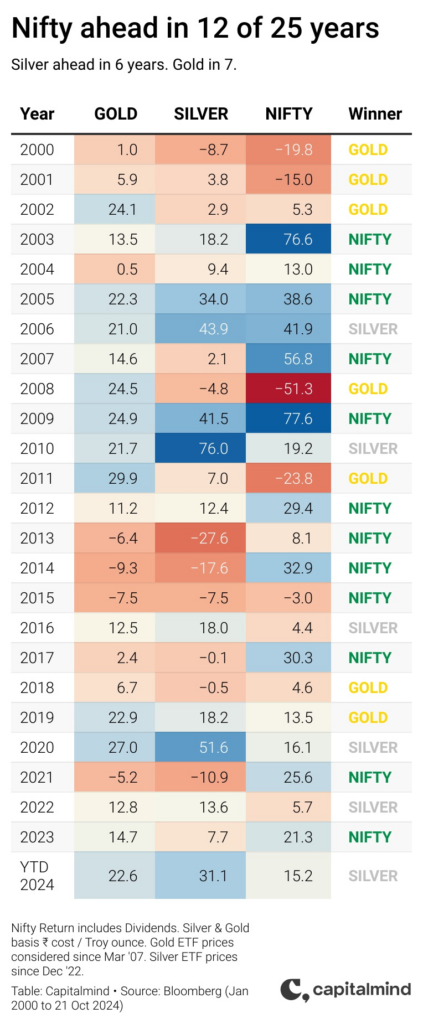Nifty, Gold, and Silver: A Comparison Over 25 Years
Over the past 25 years, three key assets—Nifty, Gold, and Silver—have shown varying performances. Each year, one of these has emerged as the best-performing asset, giving investors different outcomes. If we look at the numbers, Nifty outperformed in 12 out of the 25 years, Silver took the lead in 6 years, and Gold was ahead in 7 years. The performance gap between these assets highlights the importance of diversifying across different asset classes.

When Silver Outperforms, Gold Also Performs Well
Silver had some standout years like 2006 and 2010, where it posted significant gains. In 2006, for example, Silver rose by 43%, while Gold also did well with a 21% return, above its long-term average of 11.5%. In 2010, Silver again performed impressively with a 76% increase. Gold, although less dramatic, still delivered a respectable 21%. This shows that during strong years for Silver, Gold also tends to do well, even if it doesn’t match Silver’s gains.
Gold as a Steady Performer
While Silver may have more volatile performance, Gold has been a more stable asset. Over the long term, Gold has an average return of around 11.5%. There were several years where Gold exceeded this average, particularly when Silver also performed well. For instance, in 2020, Gold saw a return of 27%, while Silver was up 51.6%. This consistent performance makes Gold a valuable asset for those looking for long-term stability, especially during uncertain times.
Nifty vs Gold: Different Assets, Different Roles
Although this comparison shows Nifty and Gold as competitors, it’s important to see them as complementary. Nifty, which represents the stock market, tends to outperform during strong economic periods. However, in years when Nifty did not perform well, Gold often provided a cushion. For instance, during the 2008 financial crisis, Nifty fell by 51%, but Gold gained 24%. Similarly, in 2011, Nifty dropped 23%, while Gold rose by 29%. These examples show how Gold can serve as a hedge during stock market downturns.
No Perfect Inverse Correlation, But Still a Hedge
While there isn’t always a perfect inverse relationship between Nifty and Gold, the trend is clear—when Nifty struggles, Gold often performs better. There are exceptions, like in 2013-2015, where Nifty did well while Gold was down. However, in many cases, Gold has provided protection when stocks declined. This makes Gold an important asset to include in a portfolio alongside equities, helping to reduce risk and smooth out returns.
Why You Should Include Gold in Your Portfolio
By adding Gold to an equity-heavy portfolio, you can create a balance. Gold acts as insurance, reducing the overall risk and helping to protect against major losses during bad years for stocks. Over the past 25 years, the combination of Nifty and Gold has shown that this strategy can reduce the impact of drawdowns and improve long-term stability. For investors looking for a smoother equity curve, adding Gold can make a big difference in managing risk while still aiming for growth.
Disclaimers and disclosures : https://tinyurl.com/2763eyaz
If you have any questions, please write to support@weekendinvesting.com













